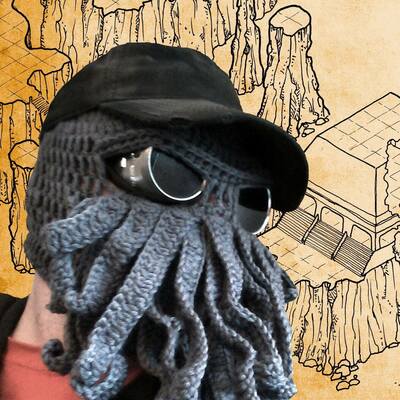The thing about traps feels like very naive advice. They suggest just “add more traps” to make it feel more old school, but they don’t discuss what makes a good trap. They mention that traps should do different amounts and types of damage, but that’s far from the most important consideration. If you just peppered a bunch of pit traps and swinging blade traps all over the place it wouldn’t necessarily make for a fun dungeon. Trap-heavy can be good, but you need to be thoughtful about making each trap an interesting puzzle to solve rather than just a bunch of “Oops, you forgot to say you were looking for traps. Take 2d6 damage!”
That’s an apt observation!
I struggled with traps a lot in the past, both as GM and as player, because the “Oops, your forgot to say…” you describe just never felt like an interesting or satisfying outcome, and handling traps speculatively dragged the pace down and distracted a bit from the core of what’s fun for my groups.
What opened my eyes was Chris McDowall (of Into the Odd & Electric Bastionland), saying that how one reacts to obvious danger, so to paraphrase: taking decisions on known and open ended problems, is one core element of RPG gameplay. You cannot make useful decisions, if you are missing too much info, otherwise it starts becoming gambling. And this really turned my mind around on using traps. I generally try to follow these recommendations from old-school or old-school adjacent games:
- Characters generally see signs of traps, if they are not running, distracted, etc. So for example: obvious holes in the wall, prior unlucky adventurer’s remains with and obvious appropriate wound, etc.
- Taken from old-school DnD: traps do not trigger reliably, but only on a 33% or 50% chance.
- Traps mostly cannot be disarmed by character skill alone, but rather the players should figure a way around it.
And in my experience, this transformed the “Oops, Take 2d6 damage!” into a fun bit of “How do we best get through this hall of spears, without getting skewered?” problem solving.
The Angry GM has a recent article on exactly this!
Thanks for sharing! I was not aware of The Angry GM, but this article looks pretty well thought out at first glance. Will add it to my reading list!
Yeah, I’m thinking in particular of the way traps and other hazards are handled in Pathfinder 2e. In that, there are two kinds of hazard: Simple and Complex. Simple hazards are the “Oops, take 2d6” variety. Complex hazards basically function like a monster, except they don’t necessarily occupy a space. They roll for initiative and on their turn they follow a “routine”. Often they end up having some particular trick you need to do in order to circumvent them, so it ends up being about figuring out how to neutralize the hazard before its next turn in initiative rolls around. And the hazard system is also used for things like natural hazards like a thunderstorm, as well as supernatural “haunts” like a library where all the books fly off the shelves to attack you.
That sounds interesting, and an approach I have not seen before. But the increased potential for interaction and reaction here sounds quite interesting - although I am not sure if initiative would slow it down too much for my tastes.
Did you apply these way of approaching traps and hazards in play yourself? What was your experience?
I have at least once. I just started running PF2e fairly recently but there is a complex hazard in the beginner box adventure. It’s like a room with a statue that activates when players step on a pressure pad in the room. The statue does a random thing on each of its turns, either attacking a single random creature in the room, attacking all of the creatures on one side of the room (left or right), or attacking every creature in the room. The statue can be disabled by disarming clockwork mechanisms at its base (or by smashing it), and the damage it can do is about 2/3 of a PC’s HP in that adventure (note that PF2e kinda assumes PCs go into every encounter fresh; there’s lots of out-of-combat healing).
When I ran this encounter recently, the PCs played it in a very interesting way, and it felt a lot more like a combat. They tried different approaches, and eventually figured out how the statue worked enough to circumvent it. But during those first couple rounds where they didn’t know what was going on, they had to frantically try things while the statue threatened to kill one of them every time its turn rolled around. They knew they could leave the room at any time, but they also knew that if they could survive one extra turn then it would mean a little bit more time to disarm the statue. It made for a very tense and exciting encounter.
Thanks for the thorough report, sounds like it was quite successful in making an interesting trap.
Now I am interested to check how this hazard is described in the beginner box. I believe I got it in a Humble Bundle once, but I did not take the time to read it.No problem! You can also check out this video which goes over the hazard system
Very true, I read a better article regarding traps at some point I’ll try and dig that up.
Yeah I feel you there. Unfortunately my last group never let go of the few times I used traps (mind you, in obvious tapped areas like dungeons or bandit hideouts etc) and started asking to look for traps multiple times for an area.
I do tell them that no traps are in the area as far as they can tell and that their experience as an adventurer that this area feels safe, but they insist :P.
As is the fun of DM’ing!
That does sound frustrating, but unfortunately there’s not really a good solution. Like in theory you could tell the group that you just aren’t going to use traps anymore, which might get them to stop searching for traps so compulsively, but then you can’t ever use traps again. Or I guess you could at least tell them that searching once is enough to get a sense of where the traps are in a large area, so they don’t have to announce they are searching quite as often.
Ben Milton’s take on traps is, I think, the best way to handle them.
Don’t use traps as a hidden thing. Make the trap itself obvious to the players, and describe it’s positioning. The trick should be for the players to figure out how to either avoid or safely disarm the trap.
One example he uses is a pit trap with a narrow board serving as a bridge over the top of it. The smell of volatiles indicates that there may be some kind of fuel at the bottom of it. The board is on a rotating mechanism, and if anyone tries to stand on or otherwise move the board, it ignites the fuel below with flint inside the mechanism, like a lighter. Since the pit is too large to jump across, players will need to find another way across.
In my own game, I recently pointed out a section of floor filled with skeletons whose legs were partially sunken into the tiles up to the knee. Since the sections of the floor were too long to jump across, they tested what was wrong by throwing objects onto the tiles and seeing what happened. Once it was clear that only objects that had been stationary for a few seconds sank in, they sprinted through the hallway and made it to the other side fine (one character lost a boot). They had fun, nobody felt it was unfair, and I would call that a win.
Unfortunately for them, the floor on the other side of this trap was greased, so they went sliding down a chute to the fourth floor of the dungeon, and had to look for a way back up, which came in the form of a previously inactive elevator that was a shortcut back to the first floor.
Sen’s Fortress in Dark Souls 1 is a good example of how traps like these can be utilized. They’re all obvious and easy to avoid, and serve more as positioning puzzles than as gotcha mechanics.
Good tips in here.
I’m running a campaign right now that’s very episodic and I’m starting to feel like I’m just running five room dungeons over and over. This will help me spice things up.
Nothing wrong with a five room dungeon, just remember that sometimes a “room” can be more than one room. A “room” can even be a five room dungeon unto itself. Also be sure to create loops, branches, and dead ends. One of the best things to discover in dungeons is when there are multiple ways of traversing them
I’m trying to keep the actual “rooms” from becoming too formulaic, it’s the episodic part that’s got me a little worried. I want my players to control the story but they’re being sent on away missions so I’m worried they feel like they’re just checking boxes:
- get to know the locals
- find the reason they’re there
- gather info
- find/kill the X but, oh no/yay, here comes Y
- repercussions for finding/killing (or not) the X
- possibly stay and party with the ewoks for a while
- head home
Of course, the missions they go on are not happening in a vacuum and affect other missions and the overall story and they choose the missions.
That sounds to me like the standard rinse-and-repeat for most D&D-style TTRPGs. Are your players complaining?
They aren’t, I should definitely keep that in mind
Try asking @dysonlogos@chirp.enworld.org
@Brunbrun6766, @dysonlogos is a dungeon drawer for WotC, as far as I know.
For WotC, Kobold Press, and a pile of other companies, yeah.
thats fantastic!






